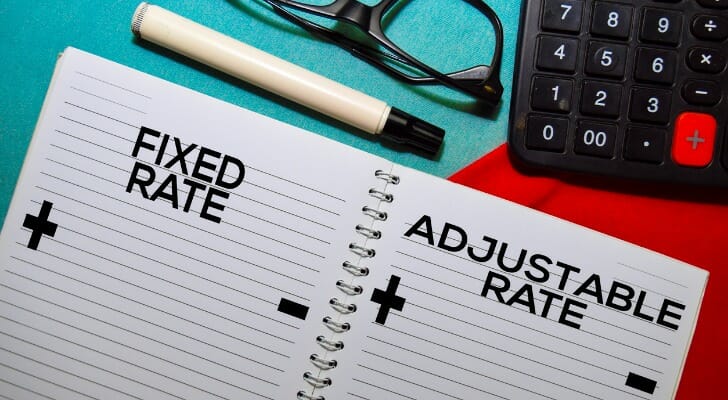With inflation continuing to affect interest rates, homeowners looking for financial relief may turn to their mortgages to help their overall budget. Adjustable-rate mortgages can bring interest rates down to affordable levels for borrowers, making homeownership possible during financially challenging times. An adjustable-rate mortgage (ARM) comes with a lower initial mortgage payment that balloons after a specific period. Buying a house is a big financial decision and you may benefit from working with a financial advisor to help you make the right decision to accomplish your financial goals.
What Is an Adjustable-Rate Mortgage?
An adjustable-rate mortgage (ARM) is a home loan offering an initially low-interest rate, sometimes called a teaser rate. The interest stays low for three to ten years, after which the rate adjusts based on the real estate market and lending trends. Interest rate adjustments happen once or twice a year, depending on the specific loan. In addition, adjustable-rate mortgages limit how much the interest rate can rise or fall.
Lenders base interest rate adjustments on related market indexes. For example, your ARM might use the Secured Overnight Financing Rate (SOFR) or the 11th district cost of funds index (COFI) to determine how much your interest rate will fluctuate. In addition, ARMs have specific cap and floor rules that dictate how much interest rates can change.
For example, let’s say you have a 7/1 ARM with a 3/1/5 cap and floor structure. These numbers mean you have an ARM with a teaser rate lasting seven years. After seven years, your interest rate will adjust once annually (hence the 7/1 designation). The 3/1/5 figures mean that once the teaser rate expires, the interest rate cannot rise by more than 3 points (hence the 3). After the first adjustment, the interest rate cannot change by more than 1 point (hence the 1). The last number is the lifetime cap. In this case, the interest rate cannot shift by more than 5 points from the initial rate (hence the 5).
Adjustable-Rate Mortgage Pros

Adjustable-rate mortgages contrast with fixed-rate mortgages, offering distinct advantages. The three most relevant pros to an ARM are:
- Reduced Interest Early On: ARMs offer lower interest rates for the first several years of the loan. However, after the initial period expires, the rate often jumps higher than most fixed-rate mortgages. As a result, ARMs help homeowners save money early on.
- Ideal Fit for Selling or Refinancing: Because ARMs have more favorable interest rates for a specific amount of years, they can work perfectly with a plan to sell your home or refinance before the initial period expires. For example, if you plan on selling your home in six years, you could get a seven-year adjustable-rate mortgage and pay off the entire mortgage with the home sale before the interest rate increases. In doing so, you’ll pay less for housing during the six years of homeownership.
- The Adjusted Interest Rate Could Drop: Once the teaser rate ends, your interest rate adjusts annually or biannually. However, the change could work in your favor because the interest rate could decrease, not increase. In this scenario, you’ll save even more money than during the first portion of the loan.
Adjustable-Rate Mortgage Cons
While ARMs can help you save money, they have potential pitfalls as well. The three most important cons to getting an ARM are:
- Dangers of An Increased Interest Rate: When your interest rate adjusts, it could jump and make your house payments unaffordable. That said, if you’re relying on the interest rate holding steady or falling, you could be set up for financial ruin if the interest rate goes up a point or two.
- Shifting Financial Circumstances: Even if you calculate payments before getting the loan to ensure you can afford the maximum possible payment, an ARM has risks. For example, you might experience job loss or a pay cut at work, jeopardizing your ability to pay your mortgage. Or, if you plan on selling your home before the initial rate expires, you might have challenges selling your home. If you can’t sell your home in time, you’ll have to start paying your mortgage with a higher interest rate.
- Prepayment Penalties: Some mortgages come with the condition that the borrower can’t pay the loan in full within a specific amount of years without owing a prepayment penalty. For example, if you have an ARM with a five-year prepayment penalty stipulation, refinancing or selling before five years will cost you thousands of extra dollars. Lenders have prepayment penalties because they want to give loans that create interest payments for many years. As a result, it’s crucial to check with a lender about prepayment penalties before signing the dotted line.
How to Find an Adjustable-Rate Mortgage
While ARMs may not be as widely available as fixed-rate mortgages, many lenders offer them even if they don’t actively advertise any. A quick Internet search can help you assess your options. Plus, family or friends with ARMs can recommend their lender if they’ve had a good experience. As with any major financial decision, doing your homework and reading everything carefully is key.
The easiest way to find an adjustable-rate mortgage is to just ask your mortgage broker what their ARM options are. However, it’s a best practice to shop around for an ARM the same way you would with a traditional mortgage. You don’t want to settle for the first loan offer that you come across in case you’re able to find a better rate or overall loan terms that will benefit you.
Is an Adjustable-Rate Mortgage Right for Me?
While a favorable interest rate can lower mortgage payments, later adjustments and possible prepayment penalties mean it’s a good idea to approach ARMs cautiously. It’s best to get an ARM for your home as part of a larger, thorough financial plan. If you fit the following circumstances, an ARM could help you toward your financial goals:
- You’re planning on moving or refinancing soon. Your timeframe for selling your home or refinancing your mortgage is vital to whether an ARM is a good fit. Remember, your ARM will need a longer initial period than your timeline to sell or refinance so you have time to make your move and avoid interest rate adjustments.
- You account for the risks. As stated earlier, plans to move or refinance could be delayed, or your financial circumstances may change. Every scenario with an ARM involves the chance of experiencing higher interest rates and more expensive mortgage payments. Borrowers who want to avoid these financial challenges may find a fixed-rate mortgage more attractive.
- You need a jumbo loan for your home. Jumbo loans are for homes whose values exceed conventional lending limits. Because the principal balances of jumbo loans are so high, the interest rates of ARMs can help borrowers save money.
- You plan on making additional payments during the initial period. A low-interest rate means more of your payment will hit the loan’s principal balance. As a result, every payment you make on the mortgage will pay down the principal faster than if you had a fixed-rate loan. For example, if you make two mortgage payments per month with an ARM and refinance before the teaser rate expires, you could obtain a fixed-rate mortgage with a reduced loan balance.
The Bottom Line

Adjustable-rate mortgages help homeowners save money with a low introductory interest rate. In addition, borrowers can sell their homes or refinance their loans to preserve their savings and avoid interest rate adjustments. However, prepayment penalties, shifting financial circumstances and ballooning interest rates pose risks to borrowers. Therefore, a meticulous approach that takes risks into account is recommended for anyone considering an ARM.
Tips for Adjustable-Rate Mortgages
- Purchasing a home is a crucial decision, and your mortgage can significantly impact your finances. Therefore, a qualified financial advisor can provide indispensable advice during your journey toward homeownership. Finding a qualified financial advisor doesn’t have to be hard. SmartAsset’s free tool matches you with up to three financial advisors who serve your area, and you can interview your advisor matches at no cost to decide which one is right for you. If you’re ready to find an advisor who can help you achieve your financial goals, get started now.
- The interest rate could be the tiebreaker among competing mortgage offers you receive. Use a mortgage calculator to see how interest affects your monthly payments.
- Mortgage preapproval is essential for house hunting and requires exhaustive financial documentation and research from borrowers. So, it always pays to have a mortgage preapproval checklist at hand.
Photo credit: ©iStock.com/Daddy1971, ©iStock.com/syahrir maulana, ©iStock.com/Weedezign
